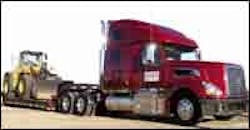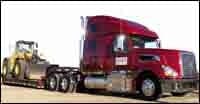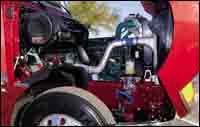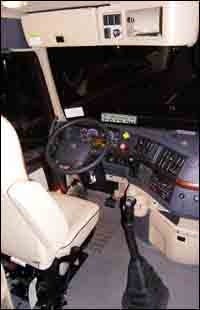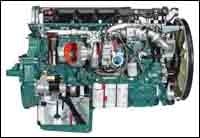Volvo's VT880 Has Big Features
Form follows function with most heavy trucks, and that's certainly true of Volvo VT880. Its primary reason for being is its new-to-North-America 16-liter diesel, which needs a big hood to house it and a large radiator to cool it. This essentially describes the new model, which comes only with Big Power engines and big dimensions from front to rear.
Yes, it's got a big sleeper, because the over-the-road owner-driver is the Volvo VT880's first market target. The sleeper alone is 77 inches long; lop that off and you'd have a daycab tractor that would measure about 123 inches from bumper to back-of-cab. This would make the model a more serious candidate for heavy hauling and thus more suitable to the construction industry. Volvo executives won't say when or even if that might happen, but in the meantime you might soon see this tractor on jobsites, pulling flatbeds and dropdecks full of supplies and equipment.
For this article, the tractor pulled a lowboy toting a wheel loader. The photos suggest the loader is not much bigger than the tractor's huge hood. While that's not the case, engineers did move the cab 8 inches rearward on a VN chassis to accommodate the hood and engine. A wide nose and square egg-crate grill cover a 1,700-square-inch radiator needed to handle the heat thrown off by high horsepower. This will become more important in '07, when emissions limits become stricter and engines will run hotter.
Any VT buyer can order plenty of power. Volvo's 16-liter D16 engine is available with 500 to 625 horsepower; the alternative is the 15-liter Cummins ISX with 475 to 565 horsepower. Prices for the two engines and the different ratings will vary, of course, but the Volvo won't necessarily be more costly than the Cummins, executives said.
Volvo VT880 has 994-cubic-inch engine
The American-spec D16 will be assembled at Volvo Powertrain's retooled plant in Hagerstown, Md., using block and cylinder-head castings from Sweden. The 994-cubic-inch inline Six was introduced in 2003 as the European D16C (the latest in a series that goes back 20 years). With an exhaust-gas recirculation system to make it emissions legal in the United States and Canada, it becomes the D16D.
Torque is worth noting. The D16D makes 1,850 to 2,250 pounds-feet. Twenty-two fifty is 200 lbs.-ft. more than maximum torque of Caterpillar's C15-625. However, Cat says it intends to remain on top of the ratings, and will probably have trumped Volvo's numbers by the time you read this. So the D16D's rein as the strongest North American truck engine will probably be rather short.
Other D16D features include an overhead camshaft operating four valves per cylinder, high-pressure fuel injection, a sliding-nozzle turbo, and rear-mounted gear train. An interesting detail is the spring-loaded design of the bolts on the cylinder head and oil pan; they'll absorb some of the shock of a catastrophic failure, should one occur.
D16Cs could barely be heard in eerily quiet Volvo FH16 high-cab-forward tractors that I drove in Sweden in mid-2003. In the VT conventional, the D16D is plainly audible but still pretty peaceful — 68 dB(A) on a decibel meter while the engine worked hard during a brief test run. Most American trucks these days register into the 70s.
The only transmission available for the Volvo VT880 is a higher-rated version of Eaton's beefy 18-speed Fuller Roadranger, either as a manual or an AutoShift. The engine doesn't always produce its maximum torque, because electronic controls sense the load demand and release torque sequentially, in 200-lb.-ft. increments, toward the strongest output. I never felt any switchover from lower to higher torque, but the system gives the gears, shafts and bearings a breather most of the time they're spinning.
'Only' a 550-hp version
The handful of gear jammers among the press corps attending the VT's February unveiling in Scottsdale, Ariz., were anxious to try out the 625-horse rating of the D16, and were disappointed that the single unit available for our drives was "only" the 550-hp version. It resided in a bright-red tractor, which we drove up and down Interstate 17 north of Phoenix.
We were impressed by the quietness of the cab (conversations in normal tones of voice were possible) and accommodations in the big sleeper (as in the VN870, it included a dinette that converts to a lower bunk, an upper bunk that left ample headroom for those seated around the table, and lots of cabinets and cubbies for storage).
The other guys pulled a loaded van trailer, but I had the hefty Ferree tri-axle lowboy — the same one used with a VHD tractor last summer (see August '04 CE) — which this time carried a 43,000-pound Volvo L110E wheel loader. The VT is a hefty tractor but its fuel tanks were mostly depleted, so our gross combination weight was probably right at 80,000 pounds and thus legal.
Kevin Thomas, my guide on that VHD drive last year, was also the host this time. He and his crew move Volvo show trucks around the country. He later weighed the VT fully fueled with 300 gallons, and reported it scaled a tad over 21,000 pounds. Production versions might be trimmer. The big sleeper probably weighs about 1,500 pounds (Volvo's spokesman wouldn't say how much), so a daycab with similar components would weigh correspondingly less than this tractor.
You might think that big hood would be hard to see over. But it's sloped downward so the view of the road ahead is quite good. The hood's sheer bulk does hide smaller cars and cycles that might be directly along the right side, but an auxiliary spot mirror might cure that. And the big side mirrors, a new design said to be more stable than the vibration-prone ones on VNs, have both flat and convex glass to give a good picture of what's next to the trailer. I never felt blinded by the hood, even in freeway and street traffic. And I quickly learned to sense where the corners were as I maneuvered.
You might also think that the VT's forward-set steer axle would make turning more difficult than the VN's setback axle, but it doesn't. The difference in axle settings is less than a foot, leaving enough swing room for wheels to cut tightly, so the VT goes through corners surprisingly well. Steering feel is typically Volvo — a tad mushy with the TRW power system and a generally soft-riding front end.
Tackling the hills in a Volvo VT880
I-17 climbs about 5,900 feet from Phoenix to Flagstaff and there are some serious grades along the way. Thomas remarked that the D16-550 was a lot stronger than Volvo's former top engine, the D12-460. As he was saying that, I was tackling the first grade by letting the engine lug in 8th-overdrive (18th ratio), and was underwhelmed by the D16-550's performance. Yes, torque was taking us up the hill, but at less than thrilling speed. On the long 6-percenter, I downshifted several times and settled in at about 35 mph and 1,600 rpm in 6th-direct (13th ratio).
Why wasn't I tearing up the hill? Because I waited too long before downshifting. "To get performance, you've got to use horsepower" which develops at higher rpm, one old driving pro told me while we were testing a Cat 3406E-550 some years ago. It, too, had slowed on a steep grade because I hadn't downshifted soon enough. This Volvo D16 behaved exactly the same way; it needed to spool up to 1,700 or more before hitting the hills. Later I did just that and sure enough, road speed stayed higher.
Speaking of spooling, the D16 turbocharger's boost gauge went as high as 40 psi under full load. When it began falling off at about 1,400 rpm, I downshifted. So the engine is a good lugger if you don't need to roar upgrade.
By the way, the transmission at first shifted well. Then as we went on, it seemed to stick in gear, slightly delaying each of my gear changes. It got really bothersome as we left the freeways and proceeded along boulevards to our hotel in Scottsdale. Two other editors also reported problems with the tranny, and I chalked it up to the fact that this tractor was a pre-production unit that might've needed some adjustments.
The D16D will appear only in the VT series. The engine's too big to fit into the VN (which can be had with lower-rated ISXs) or the vocational VHD (which comes only with the D12). And expect a list price of well above $100,000 — big money for a big truck.
Oh — what does the T in VT mean? Tough? Toothy? No. Executives say they picked T because it rhymes with V (for Volvo) and VeeTee sounds good. T has no particular meaning in the designation, except it's further into the alphabet than the N in the previously developed VN, and the N has no particular meaning, either. Really.
What will mean something is how owner-operators and some fleets already pleased with their Volvos will receive this Volvo VT880. That'll probably be E for enthusiastically.
Volvo VT800 Heavy Truck Specs
- Truck: Volvo VT64T880, conventional sleeper-cab, BBC 200 inches w/77-in. sleeper, weight 21,020 pounds w/300 gallons of fuel
- Engine: Volvo VE D16D I-Torque Plus, 550 hp @ 2,000 rpm, 1,650/1,850 lb-ft. @ 1,100 rpm , w/Kysor on/off fan drive and Volvo Engine Brake w/exhaust pressure governor
- Clutch: Eaton 15.5-in. Solo
- Transmission: Eaton Fuller RTLO-18918B, 18-speed
- Front Axle: 2,500-lb. Meritor FF961Easy Steer w/Volvo Unitized Hubs, on parabolic taperleafs
- Rear Axles: 40,000-lb. Meritor MT40-143M, on 38,000-lb. Volvo air suspension, w/54-in. spread and 3.55 ratio
- Wheelbase: 250 inches
- Brakes: Meritor S-cam w/Bendix ABS
- Tires & wheels: Goodyear 11R22.5G G395 front; G372 rear, on Alcoa Dura Bright polished aluminum discs
- Fuel Tank: Dual 150-gal. polished aluminum
- Trailer: 50-ft. by 102-in. Ferree 50-ton tri-axle lowboy
